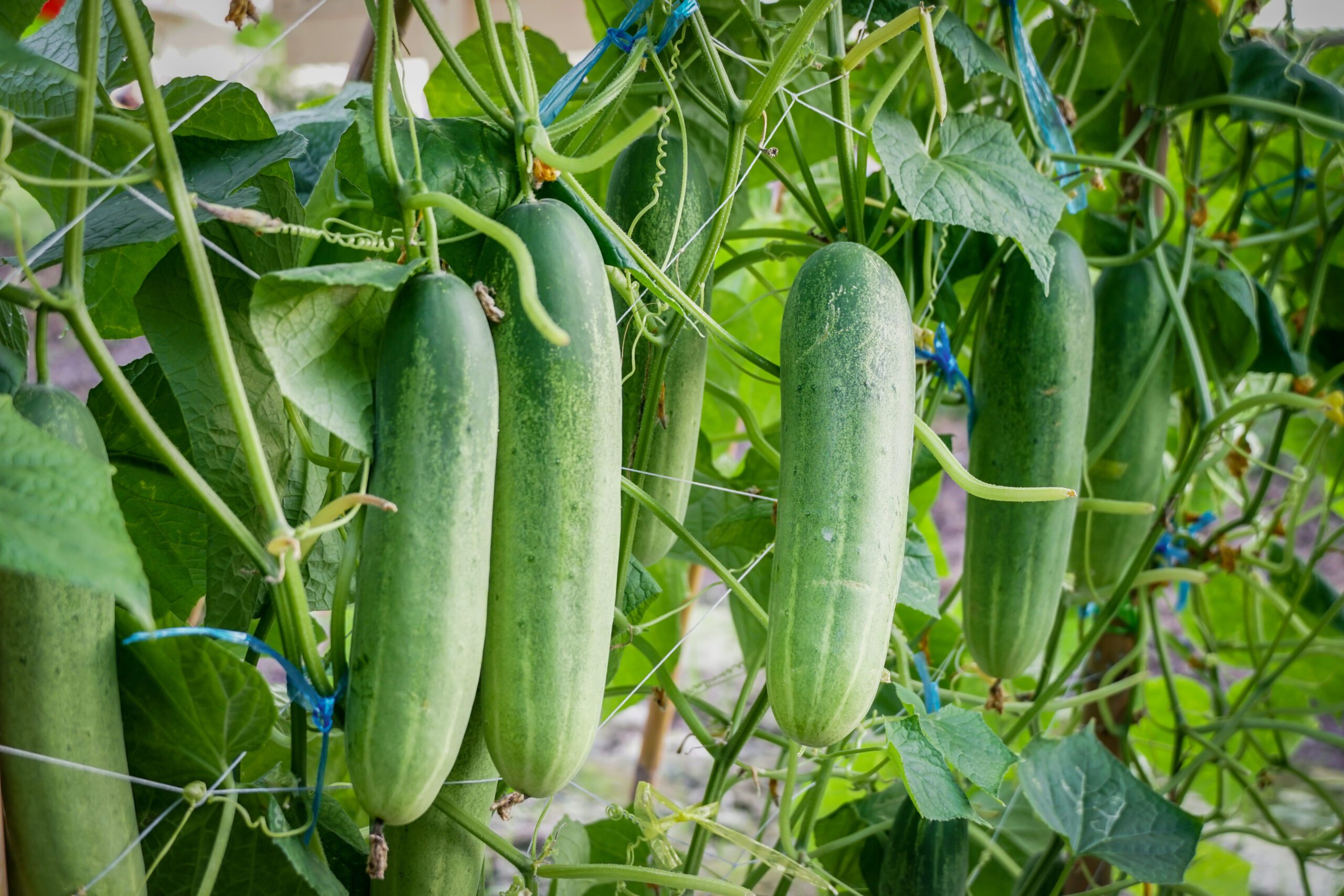
Cucumis sativus
Cucumbers are annual plants, and while they are considered to be a vegetable, technically we enjoy eating their delicately-flavored immature fruits. Made of 95% water and with a substantial dose of Vitamin K, the hydrating, cooling effect of cucumbers in food and beverages is perfect for sultry summer days and nights. The crisp crunch of a pickle is a perfect accompaniment to many meals and snacks; there is archaeological evidence that people have been pickling cucumbers for 2000 years.
Cucumbers were first domesticated in India ~3000 years ago. In the 1500s, the Spanish Conquistadors brought them to the Americas, where they introduced them to multiple Native American tribes. We have been enjoying them here ever since. Cucumbers are a creeping vine that can grow crawling along the ground or up a trellis, although there are some with a bushier growth habit.
There are 3 basic types of cucumbers:
- Slicing – long fruit, grow on a trellis for straight, uniform fruit. Harvest when 6-8”.
- Pickling – shorter and blocky. Harvest at 2-3” for sweet pickles and 5-6” for dill pickles.
- Burpless/Seedless – thinner skinned and sweeter than other types of cucumbers, and usually seedless. Burpless are reportedly easier for some people to digest than other types of cucumbers.
All these types will cross pollinate. Cucumbers do not cross with melons, pumpkins, or squash. If you are seed saving – more on that below – stick to older heirloom and open pollinated varieties.
Sowing and Planting:
Seeds are best sown when soil temperature is 70°F.
- For hills: Create a soil plateau that is 4-6” tall, spaced 3-5’ apart. Make each plateau roughly 1.5’ in diameter and plant with 4-6 seeds, then thin to 2-3 plants.
- For rows: planted ½” deep into the ground, spaced 6” apart and thin down to 10-15”, depending on type.
Check your seed packet for how long it will take to expect a harvest, usually it is between 50-70 days.
Grow cucumbers in sunny locations with 6-8 hours of direct sunlight. Provide them with even amounts of water (1” per week) and ample nutrients. Organic fish-based fertilizers, such as Neptune’s Harvest, can start to be applied when the plants begin blooming. They will be happiest in a soil pH of 6 – 6.5. Stressed plants due to an inconsistent environment (heat stress, drought) and misshapen fruits from improper pollination are more likely to be bitter. Mulch will help keep the soil cool and moist, while also deterring weeds.
Growing cucumbers on a trellis or vertical structure is recommended. These can make the vines easier to manage, help the foliage to dry off faster which can help decrease disease issues, and will help to grow nice uniformly-shaped fruits.
Avoid interacting with the vines when they are wet, in order to avoid spreading diseases.
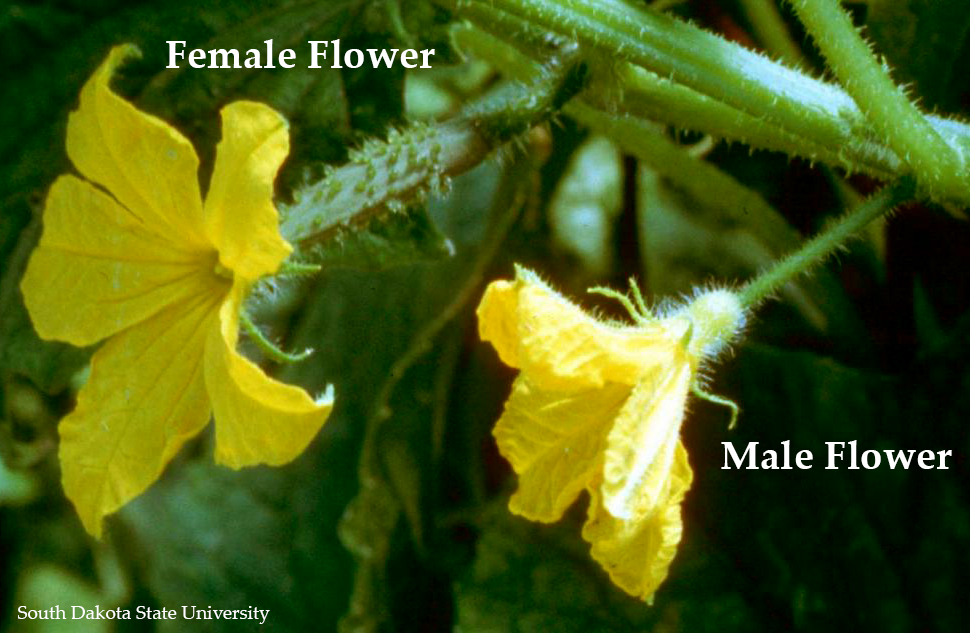
Pollination:
Normal cucumbers have male and female flowers on the same plant (monecious). The first flowers will be mostly male, and will NOT produce any fruit yet. Be patient until the plant produces female flowers.
Newer types of cucumbers are predominantly female (gynoecious) for earlier production and higher yields overall. They have also been bred for superior disease resistance (such as resistance to powdery mildew), decreased bitter flavor, and higher yields; however only heirloom and open pollinated varieties are appropriate for seed saving.
Cucumber flowers are only biologically receptive within 4-5 hours of opening, and they generally persist only for one day. Their flowers are mostly pollinated by bees. If you don’t have enough bees due to cold or wet weather, pesticide usage in your area, or you’re in an urban setting, you can always become a bee by taking a small paintbrush and gently jiggling the paintbrush inside a male flower and then repeating that action in the female flowers, early in the morning with freshly opened flowers. Attract bees to your garden by planting a diversity of flowers that bloom from spring to fall.
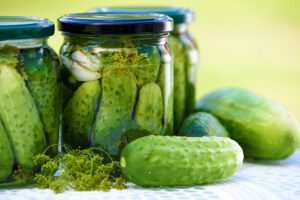 Harvesting: Cucumbers are harvested for eating when, from the plant’s standpoint, they are still immature and the seeds are not yet fully developed. Harvest when fruits are still green, before they turn to yellow (see harvest size recommendations above). Harvest often, around 4x to 5x a week, and remove any fruits that are ready and those that are too big, in order to keep the plants productive. Any old fruits left on the vine will slow production of new flowers.
Harvesting: Cucumbers are harvested for eating when, from the plant’s standpoint, they are still immature and the seeds are not yet fully developed. Harvest when fruits are still green, before they turn to yellow (see harvest size recommendations above). Harvest often, around 4x to 5x a week, and remove any fruits that are ready and those that are too big, in order to keep the plants productive. Any old fruits left on the vine will slow production of new flowers.
The ideal storage temperature for storing cucumber fruits is 55°F. When they are stored in a fridge they can develop sunken spots, which is cold damage. If fruits are bitter, the bitterness is usually concentrated just underneath the skin and at the stem end and can be cut off.
Cucumbers are extremely versatile, and can be used in salads, drinks, soups, salsa, sandwiches, smoothies, pickled, dips (such as tzatziki or raita), and to make soothing skin masks – especially when placed over the eyes.
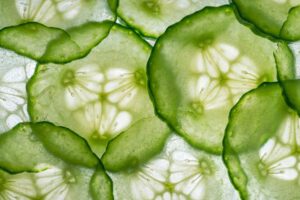 Seed Saving: Seed saving is work! Since cucumbers are pollinated by insects who fly around, it is recommended to grow a single variety and no others for ½ to 1 mile. The alternative is to bag your entire plant or just each individual flower and pollinate by hand as described above. In order to keep genetics fresh, you’ll want to do this to 5-10 of your plants (if you have a particularly rare type of cucumber, bump that up to 25 plants). Don’t harvest any of the fruits when green, you’ll want them yellow/orange and fat to allow the seeds to fully develop. Only fully developed seeds from mature fruit have the potential to be viable.
Seed Saving: Seed saving is work! Since cucumbers are pollinated by insects who fly around, it is recommended to grow a single variety and no others for ½ to 1 mile. The alternative is to bag your entire plant or just each individual flower and pollinate by hand as described above. In order to keep genetics fresh, you’ll want to do this to 5-10 of your plants (if you have a particularly rare type of cucumber, bump that up to 25 plants). Don’t harvest any of the fruits when green, you’ll want them yellow/orange and fat to allow the seeds to fully develop. Only fully developed seeds from mature fruit have the potential to be viable.
Harvest the yellow cucumbers from your best, healthiest plants with clean foliage (if your plants do not look particularly healthy, do not save seed as there’s a high risk you can be spreading diseases via the seeds). Remove the seeds, and handle them like tomato seeds: scoop the seeds out (it’s okay if there’s some pulp in there) and put in a cup of water. This is easiest with a clear cup, so you can keep an eye on things. Stir and let ferment for a few days, removing any seeds or pulp that float up to the top. Seeds that float to the top are not viable and can be discarded. Add more water as needed during these few days. Extract the seeds and allow them to fully dry on coffee filters. Store in a cool, dry location – fridges can be a great option. Cucumber seeds can last 3-4 years.
Organic Pest and Disease Management:
Stressed plants are more likely to develop diseases and succumb to pests. Be sure to keep plants healthy and happy with adequate water, sunlight, fertilizer, and excellent soil to help prevent further issues from developing. Cucumbers are usually one of the easier crops to grow here in Western North Carolina, especially when grown at the scale of a home garden.
Crop rotation is important to help reduce disease and pest pressure. If you have very limited space and cannot rotate crops, you can intercrop with another plant to try to help. Be sure to promptly remove dead plants at the end of the season, to avoid providing overwintering sites.
Floating row covers can deter pests, especially cucumber beetles and squash bugs. They need to be very well secured to the ground so no bugs sneak through under the cloth, and in place when either seeds or transplants are planted. Keep the row cover in place for roughly 30-40 days until the cucumbers start to flower in late spring and early summer, to allow the bees to pollinate the plants.
White powdery spots are likely powdery mildew, which are spread on the wind. You can grow resistant varieties, or dust with sulfur. Remove older diseased leaves and dispose of them in the trash (do not compost).
Aphids (Aphidoidea) can hide on the undersides of leaves and suck the life out of them, leaving the leaves curled and deformed. You may also see a sticky substance called honeydew, or sooty black mold. Use Insecticidal soap, Neem oil, or Horticultural oil to manage.
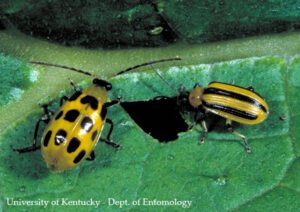 Cucumber beetles (Diabrotica undecimpunctata if it has spots, Acalymma vittatum if it has stripes) can kill cucumber plants, especially young plants, and they are also carriers of Bacterial Wilt and Squash Mosaic Virus. Neither of those diseases have cures so trying to manage Cucumber beetle populations is important. Clean up any old vegetable plant debris after plants are finished for the season. There are a handful of types of cucumbers that are more resistant (but not immune) to cucumber beetles: Ashley, Chipper, County Fair 83, Gemini, and Saladin.
Cucumber beetles (Diabrotica undecimpunctata if it has spots, Acalymma vittatum if it has stripes) can kill cucumber plants, especially young plants, and they are also carriers of Bacterial Wilt and Squash Mosaic Virus. Neither of those diseases have cures so trying to manage Cucumber beetle populations is important. Clean up any old vegetable plant debris after plants are finished for the season. There are a handful of types of cucumbers that are more resistant (but not immune) to cucumber beetles: Ashley, Chipper, County Fair 83, Gemini, and Saladin.
Planting of cucumbers can also be delayed, to try to avoid providing a delectable food source when Cucumber beetle populations are high. When seedlings have just grown their cotyledons (their first two baby leaves), one can apply an organic pyrethrin to the tops and bottoms of the leaves to help prevent issues with Cucumber beetles. Please note that organic pyrethrins are very toxic to cats and all pollinators, so use with caution and follow label instructions.
Bats and large wolf spiders are excellent predators of cucumber beetles. Consider inviting them into your garden with bat houses, leaving spiderwebs alone (allowing the spiders to do their thing), and using as few pesticides as possible. In order to keep beneficial wildlife around, they do need consistent food sources during their active seasons.
Pickleworms (Diaphania nitidalis) usually show up relatively late in the growing season, around August and September here in North Carolina. They are moths that will lay eggs on the actively growing parts of cucumbers, such as fresh new shoots and flowers. Their larvae will burrow into the fruits and flowers, leaving neat round holes, and they are voracious eaters. Pickleworms are extremely attracted to summer squash, and planting a few plants near cucumbers can work as a trap crop. Insecticidal soaps, Neem oil, Horticulture oil, and organic pyrethrins can be used to deal with pickleworms. If pickleworms are a particularly nasty issue in your garden, switch to trying to get your cucumbers in the ground and establish them as soon as possible, so you can get plenty of good production time in before they arrive.
Spider mites are invisible to the eye, but they leave tiny dots on leaves, and the leaves start to turn yellow or brown. In advanced infestations, fine webbing which resembles spider webs can be seen on the undersides of leaves, or between the leaves and stems, wherever they can make a nest. Treat with Neem oil, Horticultural oil, or Insecticidal soap. Advanced cases may require multiple treatments.
Squash bugs are difficult to deal with. Research from Iowa State University had the best results using a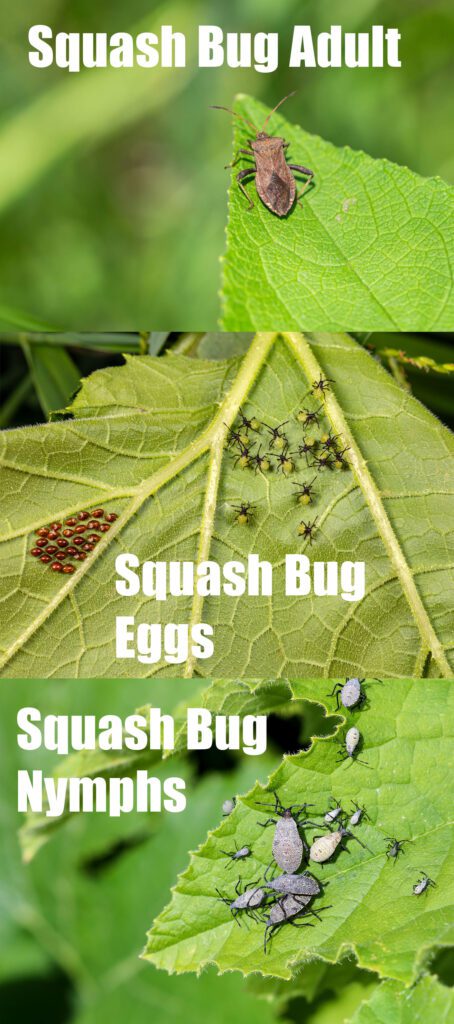 combination of newspaper and hay as a mulch, combined with well secured row covers. This combination provided effective control of both weeds and squash bugs.
combination of newspaper and hay as a mulch, combined with well secured row covers. This combination provided effective control of both weeds and squash bugs.
Every 2-3 days adults and nymphs can be handpicked, and the egg clusters on the undersides of leaves smushed, sprayed with Neem oil or Horticulture oil, removed with extra sticky tape, or by removing the leaves entirely. Squash bug adults are tough and resilient but the eggs and nymphs are more vulnerable, making them the ideal time to tackle this pest.
You can create traps in your garden by placing heavy cardboard or wooden boards next to your cucumber plants. The squash bugs will think the hidden environment underneath is a great place to spend the night. In the morning flip the boards and feed the gathered squash bugs to chickens or just stomp on them.
You can also invite their predators such as spiders, mites, ground beetles, robber flies, and parasitic nematodes into your garden to help combat squash bugs. Allow nature to help you in the garden – creating a little ecosystem can make gardening so much easier!
